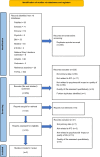The Psychosocial Impact of Indwelling Pleural Catheters: A Scoping Review
- PMID: 37575731
- PMCID: PMC10413413
- DOI: 10.7759/cureus.41689
The Psychosocial Impact of Indwelling Pleural Catheters: A Scoping Review
Abstract
We aimed to identify research on the psychosocial impact of Indwelling Pleural Catheters (IPC); report on the extent, range, and nature of studies; and summarize the findings. A secondary aim was to capture reports on patient support needs and/or self-management of IPC. A systematic literature search was undertaken, with evidence synthesis planned if sufficient literature was identified. We searched ten databases available through the United Kingdom National Health Service Knowledge and Library Hub: the British Nursing Index (BNI), Cumulative Index to Nursing and Allied Health Literature (CINAHL), Cochrane, Excerpta Medica Database (Embase), Exerpta Medica Care (Emcare), E-thesis Online Service (EThOS), Medical Literature Analysis and Retrieval System Online (Medline), National Grey Literature Collection, Psychological Information Database (PsycInfo), and PubMed. We included studies reporting on the psychosocial impact of indwelling pleural catheters or their effect on quality of life (QoL). The latter was limited to those studies using qualitative research methods from which we could identify psychosocial impacts. The evaluation of psychosocial factors was not the primary objective of any identified study, and we found no studies in which quality of life was assessed using qualitative methods. Two studies met the inclusion criteria but only tangentially. While indwelling pleural catheters may improve the quality of life in patients with pulmonary effusion when assessed quantitatively, there is a dearth of research examining their psychosocial impact.
Keywords: indwelling pleural catheter; ipc; pleural effusion; psycho-social impact; psychosocial impact; quality of life (qol); scoping review; systematic scoping review; tunneled pleural catheter.
Copyright © 2023, Peel et al.
Conflict of interest statement
The authors have declared that no competing interests exist.
Figures

References
-
- The modern diagnosis and management of pleural effusions. Bhatnagar R, Maskell N. BMJ. 2015;351:0. - PubMed
-
- Bodtger U, Hallifax RJ. Maskell NA, Laursen CB, Lee YCG, et al., eds. European Respiratory Society, Sheffield, UK. Sheffield: European Respiratory Society; 2020. Epidemiology: Why is Pleural Disease Becoming More Common?
-
- Development and validation of response markers to predict survival and pleurodesis success in patients with malignant pleural effusion (PROMISE): a multicohort analysis. Psallidas I, Kanellakis NI, Gerry S, et al. Lancet Oncol. 2018;19:930–939. - PubMed
-
- Breathlessness predicts survival in patients with malignant pleural effusions: meta-analysis of individual patient data from five randomized controlled trials. Mishra EK, Muruganandan S, Clark A, Bhatnagar R, Maskell N, Lee YC, Rahman NM. Chest. 2021;160:351–357. - PubMed
Publication types
LinkOut - more resources
Full Text Sources
Miscellaneous
